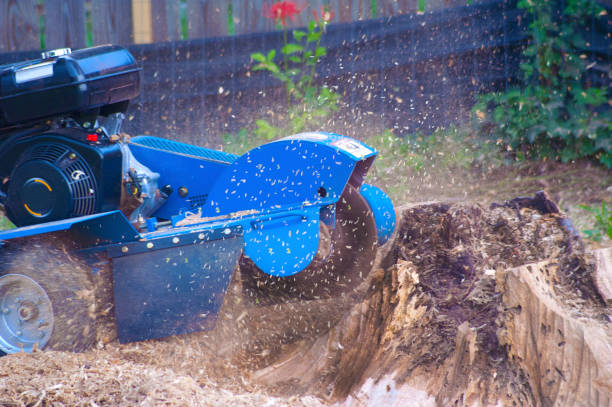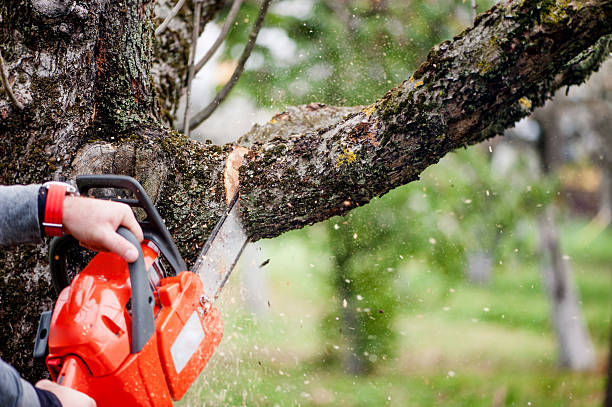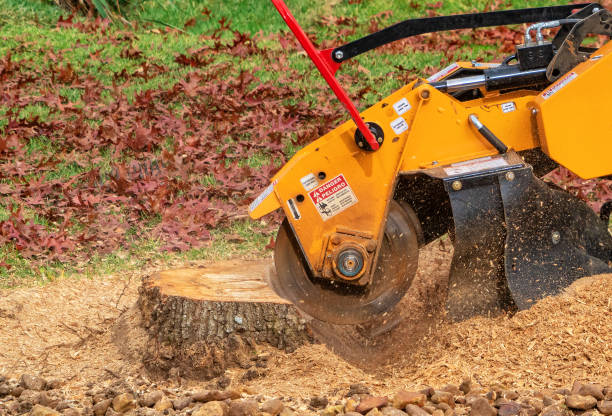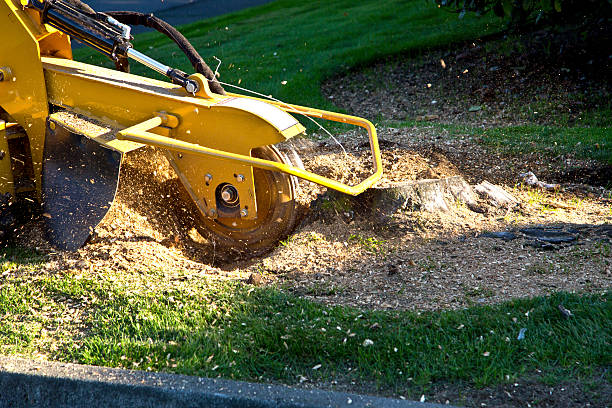
Trees are essential components of any property, providing shade, beauty, and environmental benefits. However, maintaining their health and ensuring they thrive requires professional care. Professional tree services go beyond simple maintenance; they are vital for safeguarding trees and enhancing the overall health of your property.
Protecting the Structural Integrity of Trees
Professional arborists understand the complexities of tree biology and can:
– Assess a tree’s structural integrity to identify potential hazards.
– Provide targeted pruning to remove weak or damaged branches.
– Diagnose diseases or pests that could compromise a tree’s stability.
By addressing these concerns early, professionals prevent potentially costly damage to nearby structures or landscapes.
Promoting Tree Health
Routine care by experts ensures trees remain healthy and robust:
– Proper Pruning Techniques: Professionals know how to trim trees in ways that encourage balanced growth while avoiding stress to the plant.
– Soil Management: They test soil conditions and recommend treatments like aeration, fertilization, or mulching to ensure optimal nutrient absorption.
– Pest and Disease Control: Early identification of infestations or infections allows for quick treatment before the problem spreads.
These specialized practices help trees thrive for years while maintaining aesthetic appeal.
Enhancing Property Value
Healthy, well-managed trees significantly impact real estate value by improving curb appeal. According to studies, properties with mature trees often see an increase in market value by 7%–19%. In addition:
– Shady areas reduce energy costs during warmer months by lowering cooling needs.
– A well-landscaped yard creates a welcoming atmosphere that leaves a lasting impression on visitors or potential buyers.
Safety Considerations
Overgrown branches or leaning trees pose safety risks during storms or high winds. Professional services mitigate these risks through:
1. Tree Inspection – Identifying weak limbs likely to fall under pressure.
2. Emergency Removal – Safely removing hazardous trees threatening people or structures.
For homeowners prioritizing safety, investing in professional care is essential.
| Service Type | Benefits Provided | Frequency Recommended |
| Tree Pruning | Encourages growth & prevents structural weakness | Annually |
| Soil Management | Improves nutrient availability & overall tree health | As needed based on soil tests |
| Pest/Disease Control | Prevents widespread infestation & damage | At first signs of issues |
| Emergency Services | Eliminates immediate threats caused by fallen limbs | As emergencies arise |
Sustainability and Environmental Impact
Trees play a critical role in combatting climate change by absorbing carbon dioxide and providing oxygen. Without proper care, dying or diseased trees contribute less to these ecological benefits. Regular maintenance fosters ecological balance while ensuring your property stays green and vibrant year-round.
Investing in professional tree services is not just about aesthetics—it ensures healthier landscapes, safer surroundings, increased property value, and positive environmental contributions throughout your community.
Expert Tree Removal Akron OH: Ensuring Long-Term Tree Health
Trees are vital assets to any property, offering shade, beauty, and environmental benefits. However, maintaining their health requires more than occasional watering and basic care. Professional tree care services play a crucial role in ensuring the long-term well-being of your trees. Here’s a detailed look at why professional tree care is essential for their longevity and vitality.
Enhance Your Landscape with a Trusted Tree Removal Company Akron OH
- Pruning: Regular pruning helps remove dead or diseased branches that can hinder growth.
- Soil Analysis: Professionals assess soil quality to ensure it contains the necessary nutrients for optimal tree development.
- Fertilization: Targeted fertilization nurtures trees by supplementing nutrient deficiencies.
- Pest and Disease Management: Trained arborists can identify early signs of pest infestations or diseases and apply appropriate treatments.
By addressing these factors consistently, professionals help trees grow stronger and more resilient over time.
Expert Tree Cutting Service Akron OH for Preventing Hazards
- Identifying weak or damaged branches that pose potential hazards.
- Removing overgrowth near power lines or structures to prevent property damage.
- Conducting structural assessments to ensure tree stability during storms.
By engaging professionals, you protect your property, reduce liability risks, and safeguard people in areas surrounding your trees.
Enhanced Aesthetic Appeal
- Crown thinning: Improves light penetration without compromising the overall shape.
- Crown raising: Removes lower branches for better clearance beneath the canopy.
- Seasonal pruning: Maintains symmetry and promotes lush foliage growth throughout the year.
These methods make properties more visually appealing while boosting curb appeal for homeowners or businesses.
Long-Term Cost Savings
| Problem Addressed | Cost Without Professional Care | Cost With Professional Tree Services |
| Untreated disease spreading | Potential loss of multiple mature trees | Targeted treatment prevents widespread damage |
| Storm-related branch breakage | Emergency removal & possible structural property repair | Regular pruning minimizes storm impact |
| Pest infestation | Structural damage from termites entering via trees | Early intervention avoids extensive treatment costs |
Professionals prevent costly emergencies by proactively managing potential issues before they escalate.
Supporting Environmental Sustainability
- Improving air quality through carbon dioxide absorption.
- Reducing soil erosion with robust root systems.
- Providing habitats for wildlife within ecosystems.
Professional care ensures these ecological benefits continue uninterrupted by keeping trees alive longer and thriving in urban spaces where environmental pressures are higher.
Customized Care Plans Tailored to Your Trees
- Managing invasive species common in specific regions.
- Selecting appropriate fertilizer blends suited for local soil conditions.
- Scheduling seasonal adjustments based on regional weather patterns.
Tailored plans ensure optimal health outcomes suited specifically for your landscape while maximizing long-term returns from healthy greenery investments.
Professional tree care is an indispensable component when aiming for vibrant landscapes year-round while avoiding costly pitfalls associated with neglecting this critical aspect of property management. By partnering with specialists who understand every facet involved—ranging from disease prevention strategies down through aesthetics enhancement techniques—you empower both nature’s resilience itself along improving surrounding human experiences effectively likewise sustainably benefiting broader communities indirectly too altogether seamlessly alike everywhere broadly comprehensively
The Benefits of Professional Tree Care for Long-Term Tree Health
Proper tree care is essential for maintaining the health, safety, and aesthetic appeal of your property. Trees are living organisms that require regular attention and maintenance to thrive. Engaging professional tree care services not only enhances the long-term vitality of your trees but also protects your landscape investment. Below, we outline the key benefits of professional tree care for long-term tree health.
Reasons to Invest in Professional Tree Care
- Expert Knowledge and Experience
Professionals have specialized training and knowledge about tree biology, growth patterns, soil conditions, and pest management. Their expertise ensures that each tree receives tailored care based on its species, age, and environment. - Early Detection of Problems
Tree experts can identify signs of disease, pest infestations, or structural issues before they become critical problems. Early intervention minimizes damage, preserves tree health, and reduces costly removals or treatments. - Proper Pruning Techniques
Pruning is essential for maintaining a healthy structure and preventing hazards such as falling branches. Improper pruning can weaken trees or cause long-term damage. Professionals use precise techniques to remove dead or overgrown branches while promoting natural growth. - Improved Safety
Large trees near homes or utility lines can pose safety risks if not properly maintained. Certified arborists have the equipment and skills necessary to handle hazardous situations safely.
Key Benefits for Long-Term Tree Health
| Benefit | Description |
| Enhanced Growth | Regular pruning promotes balanced growth and improves access to sunlight |
| Pest Management | Arborists identify infestations early and recommend targeted solutions |
| Disease Prevention | Proper care reduces vulnerability to common fungal infections or rot |
| Structural Integrity | Pruning improves branch structure, strengthening trees against storms |
| Extended Lifespan | Well-maintained trees live longer and remain aesthetically pleasing |
Services Offered by Professional Tree Care Providers
- Tree Health Assessments: Comprehensive evaluations of a tree’s condition.
- Nutrient Management: Soil treatments to ensure optimal nutrient levels.
- Cabling & Bracing: Structural support methods for weak or mature trees.
- Pest & Disease Control: Integrated approaches to manage threats without harming surrounding plants.
- Tree Trimming & Pruning: Promoting healthy growth by removing deadwood or excess branches.
- Emergency Storm Cleanup: Removing debris after severe weather events.
Why Prioritize Long-Term Care?
Investing in professional care pays dividends over time by ensuring healthier trees with fewer risks associated with decay or instability. Healthy trees improve air quality, provide shade during hot months, increase property value, and create a more inviting outdoor space for years to come.
By entrusting your landscape’s most valuable assets—your trees—to qualified professionals with experience in their maintenance needs, you safeguard both their vitality and the overall aesthetic harmony of your property environment.
Expert Tips for Tree Pruning Akron OH: Ensuring Safe and Reliable Results
Selecting a reliable tree service provider is crucial for maintaining the health, safety, and appearance of your property. With numerous companies offering various services, it can be overwhelming to determine which provider best suits your needs. Below are essential considerations and strategies to guide you in hiring the right tree service professionals.
Why Choosing the Right Provider Matters
Trees are valuable assets that enhance property aesthetics, provide shade, improve air quality, and increase property value. However, improper tree care or removal practices can lead to:
– Injury or property damage: Poorly executed trimming or removal can cause accidents or structural damage.
– Tree health deterioration: Incorrect pruning may harm a tree’s long-term health.
– Legal liabilities: Failing to comply with local regulations regarding tree removal or maintenance could result in fines.
By choosing a reputable provider with expertise and proper credentials, you ensure safety while protecting the long-term investment in your landscaping.
Factors to Consider When Selecting a Tree Service Provider
- Verify that the company holds proper licensing for operating in your area.
- Ensure they have certifications from recognized organizations like the International Society of Arboriculture (ISA).
- Request proof of liability insurance to cover potential damages to your property during the job.
- Confirm that they offer worker’s compensation insurance for their employees’ protection.
- Look for companies with several years of experience providing services such as pruning, stump grinding, or tree removal.
- Ask about their arborists’ training and if they follow industry standards like ANSI A300 guidelines for tree care.
- Read online reviews from platforms like Google or Yelp to gauge customer satisfaction.
- Request references from previous clients and ask about their experience working with the company.
- Service Offerings
Choose providers offering comprehensive services such as:- Tree inspection and health assessments
- Pruning and trimming
- Emergency storm damage cleanup
- Stump grinding/removal
- Safety Standards
Ensure that the provider follows strict safety protocols by:- Using appropriate personal protective equipment (PPE)
- Employing safe climbing techniques or aerial lifts when necessary
- Transparent Pricing
Obtain detailed quotes that outline:
| Service | Cost Estimate | Notes | |———————-|———————–|—————————-| | Tree Removal | $200–$2,000+ | Varies by size/complexity | | Trimming/Pruning | $75–$1,000+ | Based on scope of work | | Stump Grinding | $100–$400+ | Depending on stump size
Avoid companies offering extremely low bids without clear explanations; this could indicate subpar workmanship or lack of insurance coverage.
- Environmental Practices
Professional providers should prioritize environmentally responsible practices such as recycling wood waste into mulch or following eco-friendly disposal methods.
Red Flags to Watch Out For
Be cautious of these warning signs when evaluating potential providers:
– Lack of proper licensing or insurance documentation – High-pressure sales tactics demanding immediate decisions – No written contract outlining scope of work – Failure to provide references upon request
Final Thoughts on Choosing Wisely
Hiring a professional tree service provider requires careful vetting to ensure reliable results that prioritize safety and environmental responsibility while maintaining your trees’ health and beauty over time.
Recognizing the Importance of Expert Tree Removal and Trimming Services
Proper tree removal and trimming are integral components of professional tree care services. These tasks not only enhance the aesthetic appeal of your property but also safeguard its overall health, functionality, and safety. Here’s a detailed look at why expert tree removal and trimming services are essential.
The Role of Tree Removal in Property Management
- Safety Concerns: Dead or damaged trees can fall unexpectedly during storms or high winds, putting lives and property at risk.
- Preventing Disease Spread: Diseased trees can infect nearby healthy trees if not removed promptly.
- Structural Interference: Trees growing too close to buildings, power lines, or underground utilities may cause damage that necessitates their removal.
- Creating Space for New Projects: Sometimes trees must be removed to make way for construction projects or landscaping redesigns.
Professional arborists assess the condition of your trees and determine whether removal is the best option. They follow strict safety protocols to mitigate risks during the process.
Why Regular Tree Trimming Matters
- Improved Tree Health: Removing dead or diseased branches prevents decay from spreading to healthier parts of the tree.
- Enhanced Growth: Proper pruning encourages stronger branch structure and better air circulation throughout the canopy.
- Reduced Risk of Damage: Regularly trimmed branches are less likely to break under heavy winds or snowfall.
- Better Sunlight Exposure: Thinning out dense foliage allows sunlight to penetrate lower sections of the tree and surrounding plants.
Professional Expertise Matters
- Proper assessment of tree health and structural stability.
- Safe use of advanced tools like chainsaws, rigging systems, and cranes when necessary.
- Compliance with local regulations concerning tree removal permits where applicable.
| Service Type | Key Benefits | Recommended Frequency |
| Tree Removal | Eliminates hazards; creates space | As needed |
| Tree Trimming | Enhances health; reduces risks | Annually or biannually |
Environmental Considerations
Expert service providers often prioritize sustainable practices by recycling removed wood into mulch or firewood, thus minimizing waste. Additionally, they may offer guidance on replanting native species that benefit local ecosystems.
By prioritizing expert tree removal and trimming services, property owners can maintain a safe, attractive outdoor environment while fostering long-term ecological balance on their land.
Strategies for Selecting the Best Landscaping and Tree Care Professionals
Selecting the right landscaping and tree care professionals is crucial for maintaining the health, safety, and beauty of your outdoor space. With so many providers available, it’s important to know what to look for to ensure you receive high-quality services tailored to your specific needs. Below, we explore key strategies for making an informed decision.
Assess Qualifications and Certifications
- Memberships: Look for affiliations with organizations like the International Society of Arboriculture (ISA) or Tree Care Industry Association (TCIA).
- Certifications: Verify if they employ ISA Certified Arborists or other trained specialists who understand industry best practices.
- Licensing and Insurance: Ensure the company has state-required licenses and carries liability insurance to protect against accidents or damage during their work.
Understand Their Range of Services
- Tree trimming and pruning
- Tree removal
- Stump grinding
- Emergency storm cleanup
- Disease diagnosis and treatment
- Planting and landscape design assistance
Choosing a provider that offers a wide array of services can save you time by consolidating maintenance under one trusted professional.
Request References or Reviews
- Ask for references from past clients.
- Request before-and-after photos of completed projects.
- Check their online portfolio or website to review testimonials.
Consistent positive feedback is a good indicator of quality work.
Compare Estimates and Contracts
| Aspect | Why It Matters |
| Scope of Work | Clarifies exactly what services will be performed |
| Timeline | Provides an expected start-to-finish schedule |
| Pricing Breakdown | Outlines costs for labor, materials, etc., ensuring transparency |
| Warranty/Guarantee Details | Ensures coverage if issues arise after completion |
Ask About Safety Protocols
- Use of personal protective equipment (PPE) like helmets, gloves, harnesses, etc.
- Compliance with OSHA guidelines.
- Pre-work risk assessments.
Providers who emphasize safety reduce potential risks to your property while safeguarding their team members.
Prioritize Communication Skills
- Observe how clearly they explain their process.
- Ask questions about methods used—professional companies should provide thorough answers.
- Confirm responsiveness regarding scheduling or concerns raised throughout the project timeline.
Reliable communication ensures both parties are aligned on expectations throughout every stage of service delivery.
By carefully evaluating these factors when selecting landscaping and tree care professionals, you can confidently invest in experts who will enhance both the aesthetic appeal and overall health of your property’s greenery long-term.
Key Insights into Comprehensive Tree Services for a Beautiful Landscape
Comprehensive tree services play a vital role in creating and maintaining a beautiful, safe, and functional outdoor space. Whether you’re a homeowner or managing a commercial property, understanding the scope of professional tree services can help you make informed decisions about your landscape.
Core Tree Services That Enhance Landscapes
- Encourages healthy growth by removing dead or diseased branches.
- Enhances the overall shape and balance of trees for visual appeal.
- Increases light penetration to grass, flowers, and shrubs beneath trees.
- Selection of appropriate tree species based on soil type, climate, and aesthetic goals.
- Proper planting techniques to promote long-term health and growth.
- Safe elimination of dead or hazardous trees that may pose risks to people or property.
- Removal in areas where trees obstruct construction plans or compromise landscaping designs.
- Eliminates unsightly stumps that detract from the beauty of your yard.
- Prevents pests like termites or ants from inhabiting rotting stumps.
- Identification of diseases such as fungal infections, pest infestations, or nutrient deficiencies.
- Application of treatments like organic sprays or soil amendments for improved health.
Benefits of Comprehensive Tree Services
- Improved Aesthetics: Well-maintained trees enhance curb appeal by adding structure, shade, and natural beauty to outdoor spaces.
- Increased Property Value: Landscapes with healthy trees often increase property value by as much as 10-15%.
- Safety Assurance: Regular pruning reduces hazards posed by falling branches during storms.
- Environmental Health: Healthy trees improve air quality, provide shade that reduces energy costs during hot months, and support local ecosystems.
Table: Comparison Between DIY Maintenance & Professional Tree Services
| Aspect | DIY Maintenance | Professional Tree Services |
| Knowledge & Expertise | Limited knowledge; prone to errors | Trained experts with years of experience |
| Tools Required | Basic tools often insufficient | Specialized equipment for safe results |
| Safety | Higher risk for injury | Professionals follow strict safety protocols |
| Long-Term Results | May harm tree growth if done poorly | Promotes optimal health and longevity |
Signs You Need Comprehensive Tree Services
- Overgrown branches obstructing pathways or driveways.
- Trees leaning significantly after storms or heavy winds.
- Deadwood accumulation on the ground around your property.
- Fungal growth (e.g., mushrooms) at the base of trunks – an indicator of internal decay.
- Leaves yellowing out-of-season due to potential nutrient deficiencies.
Regularly assessing these indicators ensures timely intervention before problems escalate.
A commitment to comprehensive tree service is essential not just for maintaining the visual appeal of your property but also for ensuring environmental sustainability and safety over time.
Key Insights into Comprehensive Tree Services for a Beautiful Landscape
Comprehensive tree services play an integral role in creating and maintaining a stunning landscape. Proper care ensures that trees remain healthy, safe, and visually appealing while also benefiting the surrounding environment. Below, we explore various aspects of comprehensive tree services and their significance in achieving a beautiful outdoor space.
The Scope of Comprehensive Tree Services
- Tree Pruning and Trimming: Regular pruning improves tree structure, enhances aesthetics, and promotes growth by removing dead or overgrown branches.
- Tree Removal: Safe removal of hazardous or unwanted trees, ensuring minimal impact on surrounding plants and structures.
- Stump Grinding: Eliminates unsightly stumps that can detract from the appearance of your landscape while preventing pest infestations.
- Tree Health Assessments: Identifying diseases, infestations, or other health concerns to implement appropriate treatments early.
- Planting Services: Choosing the right species for your soil type and climate to enhance biodiversity in your yard.
- Emergency Storm Cleanup: Addressing fallen limbs or uprooted trees after severe weather events to restore safety and order.
These services not only enhance the aesthetic appeal of your property but also contribute to environmental sustainability by preserving healthy trees.
How Professional Tree Services Enhance Landscape Beauty
- Improved Aesthetics: Proper trimming shapes trees into visually pleasing forms that complement the overall design of your outdoor space.
- Increased Sunlight Exposure: Thoughtful branch removal allows sunlight to reach lawns, flowerbeds, and other plants underneath.
- Enhanced Safety: Removing deadwood reduces risks posed by falling branches while clearing space around structures like driveways or power lines.
- Better Soil Health: Expert arborists employ techniques such as mulching around tree bases to retain soil moisture and prevent erosion.
- Seasonal Landscaping Needs: Planning for seasonal changes ensures year-round beauty with well-maintained greenery.
Table: Benefits of Comprehensive Tree Care vs DIY Maintenance
| Aspect | Professional Tree Care | DIY Maintenance |
| Expertise | Certified arborists with specialized knowledge | Limited understanding of best practices |
| Equipment | Access to advanced tools | Basic tools may be insufficient |
| Safety | Proper risk management during tasks | Higher risk due to lack of experience |
| Long-Term Results | Ensures sustained tree health | Risk of improper care causing damage |
| Cost Efficiency | Prevents expensive future repairs | Short-term savings but potential long-term costs |
Sustainable Practices for Beautiful Landscapes
- Encouraging native plant species that thrive without excessive water usage.
- Recycling removed wood through mulch production or eco-friendly disposal methods.
- Implementing pest management strategies that minimize chemical usage while protecting beneficial organisms.
By adopting these approaches, professional tree services contribute not only to individual property improvement but also to broader environmental conservation efforts.
Investing in comprehensive tree care is essential for anyone who wants their outdoor space to flourish year after year while maintaining safety and visual appeal throughout all seasons.
- Effective Tips for Tree Pruning Akron OH: A Complete Guide
- The Essential Guide to Tree Removal Akron OH: When and How to Do It Right
- Comprehensive Guide to Stump Removal Akron OH
- The Importance of Professional Stump Removal Akron OH for Your Property’s Health
- A Beginner’s Guide to Stump Removal Akron OH: Understanding When, What, and How to Tackle Tree Maintenance Effectively
- The Essential Guide to Stump Removal Akron OH and Tree Pruning Tips for Healthy Trees






